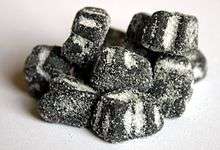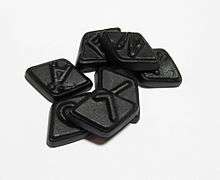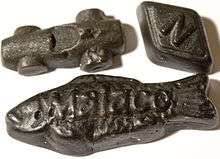Salty liquorice
 | |
| Alternative names | salmiak or salmiac liquorice |
|---|---|
| Type | confectionery |
| Main ingredients | liquorice extract, salmiak salt (sal ammoniac; ammonium chloride), brown sugar syrup, glucose syrup, sometimes anise oil |



Salty liquorice, salmiak liquorice or salmiac liquorice, is a variety of liquorice flavoured with the ingredient "salmiak salt" (sal ammoniac; ammonium chloride), and is a common confectionery found in the Nordic countries, Benelux, and northern Germany.[1] Salmiak salt gives salty liquorice an astringent, salty taste[2] (hence the name), which has been described as "tongue-numbing"[3] and "almost-stinging".[1] Anise oil can also be an additional main ingredient in salty liquorice. Salty liquorice is an acquired taste[1] and people not familiar with the taste of salmiak salt (sal ammoniac; ammonium chloride) might find it physically intense and distasteful.[4][1] Extra salty liquorice is additionally coated with salmiak salt or salmiak powder.
Salty liquorice candy and pastilles are almost always black or very dark brown and can range from soft candy to hard pastille variety, and sometimes hard brittle. The other colours used are white and variants of grey. Salty liquorice or salmiak is also used as a flavouring in other products, such as ice creams, syrups, chewing gum and alcoholic beverages.
History
Sal ammoniac (ammonium chloride) has a history of being used as a cough medicine, as it works as an expectorant.[5] Finnish author Jukka Annala speculates that salty liquorice has its origins in pharmacy stores that manufactured their own cough medicine.[6] Where and when ammonium chloride and liquorice were first combined to produce salty liquorice is unclear,[7] but by the 1930s it was produced in Sweden, Finland, Norway, Denmark and the Netherlands as a pastille.[6]
Types
Different languages often refer to salty liquorice as either "salmiak liquorice" (Swedish: Salmiaklakrits; Danish: Salmiaklakrids), or simply "salty liquorice" (Swedish: Saltlakrits; Danish: Saltlakrids). The Dutch refer to it as "Zoute Drop" or even a variety called "Dubbel Zoute Drop" (double salted liquorice drops). In Germany, they are commonly known as salt liquorice (Salzlakritz) candy and salmiak pastilles (Salmiakpastillen) or simply Salmiak, in contrast to sweet liquorice (Süßlakritz) candy. A traditional shape for salty liquorice pastilles is a black diamond-shaped lozenge. In Finnish it's known as salmiakki.
The strength of the confectionery depends on the amount of food grade ammonium chloride (salmiak salt) used, which varies by country and what's considered a safe amount. In Sweden for example, the most popular types of salty liquorice contain an average of 7% of ammonium chloride. In 2012 there was a European Union proposal to limit the amount to 0.3%, which was met with wide opposition.[8] Although the European Union now regulate the use of ammonium chloride to 0.3% in most foodstuffs, there is no specific restriction for it in liquorice or ice cream.[9] At a level of up to 7.99% ammonium chloride, salmiak pastilles are considered a "traditionally-applied medicine to assist expectoration in the airways".
An antibacterial effect can be attributed to the neutralization of the slightly acidic ammonium chloride (pH about 5.5) in relatively to base saliva (pH about 7),[10] whereby ammonia is released, which has a disinfecting effect:
- Reaction of (ammonium)-ions in base solution to ammonia and water.
Health and safety
Germany and European Union
Before implementation of the current European Union community-wide list of permitted flavouring substances used in food, national food legislation in Germany required that a content from above 2% ammonium chloride (salmiak salt) in salty liquorice, was required to carry the label "Adult Liquorice - Not Children's Liquorice" (Erwachsenenlakritz - Kein Kinderlakritz) on packaging in Germany.[11][10] When the ingredient content of ammonium chloride (salmiak salt) was between 4.49% and 7.99%, the declaration "extra strong" (extra stark) was also required on packaging. More than 7.99% of ammonium chloride (salmiak salt) was not permitted in Germany.[10]
Other uses
In addition to being used in candy, salmiak is also used to flavour vodka, chocolate, distilled rye brandy, ice cream, cola drinks, snus, and meat.
See also
- Apteekin Salmiakki, a Finnish brand of salty liquorice candy
- Lakrisal, a salty salmiak candy
- Pantteri/Katten, a Finnish gummy salmiak candy
- Salmiakki Koskenkorva, a Finnish salmiak-flavoured vodka brand
- Tyrkisk Peber (Turkish pepper), a popular brand of salmiak candy
- Pirate coins Parate or "Piratos" coins, a Danish salty liquorice shapes as coins with pirate motifs
References
- 1 2 3 4 Christine S. (8 August 2011). "In Salmiak Territory". The Harvard Crimson. Retrieved 31 March 2015.
- ↑ "Salammoniac: Salammoniac mineral information and data". Mindat.org. Hudson Institute of Mineralogy.
- ↑ Gategaeo Itkonen (25 February 2010). "Culinary stink bomb". Helsinki Times. Retrieved 31 March 2015.
- ↑ Ritva Korpimo (16 March 2005). "Mämmi Maestro". Helsingin Sanomat. Archived from the original on 5 November 2012.
- ↑ "Winter Hazards". Hennepin County Medical Center. 2004. Archived from the original on 4 March 2012.
- 1 2 "Mistä johtuu, että salmiakki on herkkua vain Pohjoismaissa?". Kysy.fi (in Finnish). Helsinki City Library. 17 October 2008. Archived from the original on 4 May 2012.
- ↑ "Minun kuuluisi tehdä esitelmä Ranskassa salmiakista, enkä ole löytänyt tietoja..." Kysy.fi (in Finnish). Helsinki City Library. 25 October 2008. Archived from the original on 4 May 2012.
- ↑ Oskar Forsberg (12 October 2012). "Saltlakritsen räddad efter beslut i EU" (in Swedish). Aftonbladet.
- ↑ "Commission implementing regulation (EU) No 872/2012 of 1 October 2012 adopting the list of flavouring substances provided for by Regulation (EC) No 2232/96 of the European Parliament and of the Council". Official Journal of the European Union. L267. 2 October 2012.
In category 5 [confectionery] – quantum satis
- 1 2 3 "Salmiak-Pastillen: Salzig und gesund?" [Salmiak lozenges: salty and healthy?] (in German). Berlin: Norddeutscher Rundfunk. 10 March 2014.
- ↑ "Erwachsenenlakritz – kein Kinderlakritz" [Adult Liquorice - Not Children's Liquorice] (in German). Berlin: Verbraucherzentrale, Lebensmittelklarheit: Internetportal gefördert im Rahmen der Initiative "Klarheit und Wahrheit" des Bundesministeriums für Ernährung und Landwirtschaft. 14 July 2017.
Books
External links
| Wikimedia Commons has media related to Salmiak candy. |
- The Finnish Salmiakki Association (in Finnish)
- Descriptions and reviews of many Danish liquorice products (in Danish)
- Mark Bosworth (4 October 2013). "Salty liquorice: The not-so-sweet sweet". BBC News. Retrieved 4 October 2013.